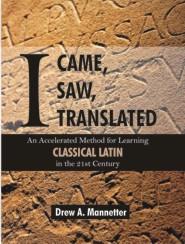
I Came, I Saw, I Translated
An Accelerated Method for Learning Classical Latin in the 21st Century
by Drew A. Mannetter
- Number of Pages: 560
- ISBN-10: 161233511X
- ISBN-13: 9781612335117
- Publisher: BrownWalker Press
- Year: 2011
- Category: Textbooks & Study Guides, Language & Lingusitics
Synopsis
I Came, I Saw, I Translated employs a new method to learn Latin. There are numerous distinctive features which set this textbook apart from others on the market. It is aimed at a mature audience of high school or college-aged students. It discusses English grammar concurrently with the Latin grammar. There is no adapted Latin; instead, a primary literature narrative is utilized from the very first word.Book Reviews:
Bryn Mawr Classical Review 2013.02.17
by Beert C. Verstraete
In nearly all Latin primers for universities and colleges, the student is guided through the grammar in a gradual and incremental manner. Typically, with nouns the first two declensions come first, along with the use of the nominative and the accusative case, and with verbs the first conjugation and perhaps the second as well, together with the present indicative active, while the student is given her first taste of the fact that Latin, unlike English, is a highly inflected language. The basic pedagogy is really not all that different from primers directed to pre-college students except that the material is covered at a much faster pace, so that one year of university Latin equals two, three, or even four years of Latin at the secondary school level. However, even then a student cannot be expected to tackle unadapted texts of classical Latin, unless in the form of extremely short snippets, and the reading of extended passages of Latin prose or poetry without any omissions or alterations must be left until the very end or until the second year; the still much used Wheelock’s Latin is a good example.
With Manneter, the student’s encounter with Latin is very different: “[T]he aim is to get students to read classical Latin and not, as most texts have it, in the future, but from the very first day of study.” (iii) The text chosen is Caesar’s Gallic War, chapters 1,2, 4, 5, 24-28. This is a good choice. Caesar shows the complex periodic-sentence structure so characteristic of classical Latin prose at its best, but is relatively free from the ornate rhetorical flourishes in Cicero and Livy. In the section on historical background (14-16), the select bibliography 17-19, the occasional note or question in the main text, and even more, the large number of study questions in Appendix E (515-546), the author also makes the student come to grips with the historical background; he is in fact expected to read much more of The Gallic War in translation. . . .
Read more @ Bryn Mawr Classical Review







 View or Post a Review at Amazon.com
View or Post a Review at Amazon.com